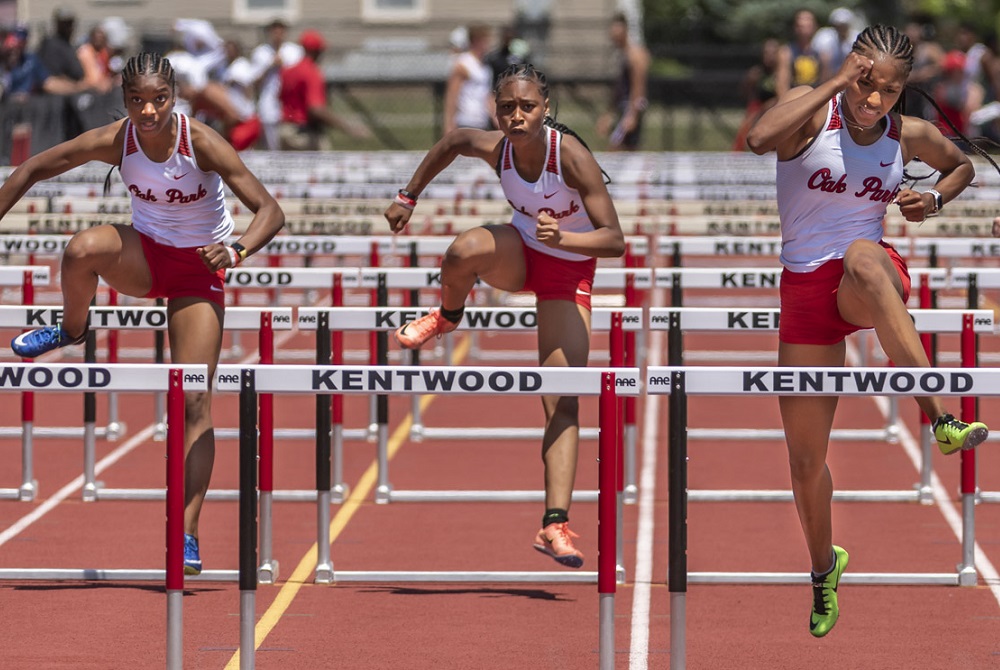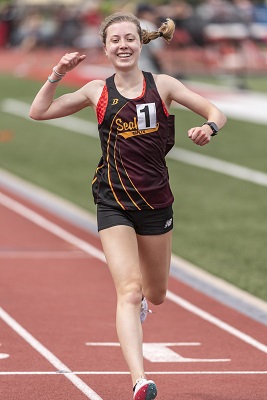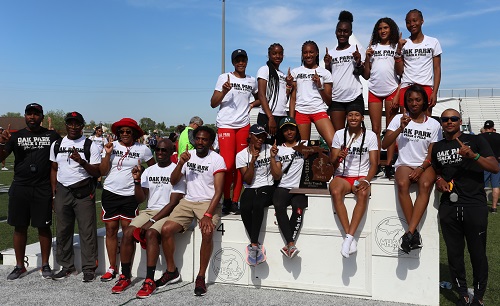
Oak Park Makes Up for Lost Time with Another Championship
By
Steve Vedder
Special for MHSAA.com
June 5, 2021
KENTWOOD – Nonah Waldron has run in all kinds of challenging conditions, but nothing like this.
The Oak Park sophomore pushed aside tough headwinds which all runners struggled with to win a pair of events at Saturday's Lower Peninsula Division 1 Girls Track & Field Finals at East Kentwood.
Waldron said she's run in heat, freezing cold and soaking rain, but never has she met up with the strong winds that buffeted Falcons Stadium. The conditions didn't seem to detract from the results, however, as she swept to victories the 100 hurdles (13.72) and 300 hurdles (43.17). The 100 hurdles time was seventh-best in state history.
"I fought them the whole races," Waldron said of the wind. "It was more mental than physical. My mind was where it was supposed to be – focused and believing in myself. But it was harder, a challenge."
Waldron said the wind wasn't going to keep her from success.
"It was definitely my goal," she said of winning twice. "I ran a 13.4 at nationals in Oregon, so I knew I had a chance."
 Waldron helped Oak Park to the team championship with 86 points. Detroit Renaissance was runner-up with 62 points, and Ann Arbor Huron third with 45.
Waldron helped Oak Park to the team championship with 86 points. Detroit Renaissance was runner-up with 62 points, and Ann Arbor Huron third with 45.
Oak Park coach Brandon Jiles said his team has been eyeing Saturday’s championship for months. Last season was canceled due to COVID-19, but Saturday’s win ran Oak Park’s title streak to three and six over the last seven seasons.
"Excellence is part of our tradition, and the kids work hard. We put a lot of work into this," he said. "We battled through adversity and made up for missing last year. We've been tough and resilient, and I think that improved our chances this year."
While the conditions were rugged for all runners, Birmingham Seaholm senior Audrey DaDamio had a fantastic meet in winning the 800 (2:11.95), 1,600 (4:44.38) and 3,200 (10:22.11). She now owns school records in the 1,600 and 3,200 and is second in the 800.
DaDamio, headed to Stanford this fall, said a clean sweep of all three events has been a goal since a successful indoor season.
"It's been something I've been looking to do all season. I thought, 'Why not?'" she said. "My season has had some ups and downs since I came off the indoor season (and indoor state record) which blew my mind. But I didn't feel like I have been able to showcase my talent in some races (this spring). That's been tough."
DaDamio said she felt strong after the 1,600 and despite temperatures in the high 80s, winning two more events seemed possible.
"I thought the bigger the risk, the bigger the reward," she said. "If I lead in a race, fine. If not, I just relax. I had confidence."
Kaila Jackson of Detroit Renaissance was also a double winner, capturing the 100 (11.70) and 200 (24.01). Jackson said she doesn't necessarily have an opinion as to which race is stronger for her.
 "They are pretty much the same," she said. "The wind held me back, but you've still got to be out there pumping your arms. Considering the wind, times weren't as fast, but it was still tough. I train hard in both events and I'm pretty strong. It's a challenge.
"They are pretty much the same," she said. "The wind held me back, but you've still got to be out there pumping your arms. Considering the wind, times weren't as fast, but it was still tough. I train hard in both events and I'm pretty strong. It's a challenge.
"I thought I had a chance because I've trained so hard. I looked at the times and thought I could do well."
Among the other winners were Lincoln Park's Karrington Gordon, who won the high jump in 5-7. Gordon, who will play basketball next season at Central Michigan, was only a ninth seed in the high jump – which she said prompted extra effort.
"I wanted to prove them wrong," she said. "I did 5-7 and a quarter three weeks ago, so I knew I wasn't far off. I knew there was good competition, and I knew I had to be ready."
Among the other individual champions were Traverse City's Leah Doezema in the discus (145-4), Sophia Mettes of Dexter in the pole vault (12-6), Opal Jackson of Macomb L'Anse Creuse North in the shot put (47-3), Alaina Diaz of Hudsonville in the long jump (19-9) and Jada Roundtree of Oak Park in the 400 (55.13).
Among the relays, Renaissance won the 800 (1:36.99) and the 400 (45.56) while Ann Arbor Pioneer won the 3,200 (9:09.43) and Oak Park the 1,600 (3:46.63).
PHOTOS: (Top) Oak Park, led by double winner Nonah Waldron (far right) dominated both hurdles races Saturday at East Kentwood. (Middle) Birmingham Seaholm’s Audrey DaDamio celebrates one of her three championships. (Below) Oak Park climbs the champion’s podium for the third straight season. (Action photos by Ike Lea; team photos by John Brabbs/RunMichigan.com.)

Hastings Relays Reigns as State's Oldest Continuous Track & Field Meet
By
Steve Vedder
Special for MHSAA.com
April 10, 2024
Bob Branch remembers dabbling in other sports, but his first love was always running.
 The Hastings High School graduate admits he could never hit a baseball, football didn't especially appeal to him and basketball was just another way to spend time with friends. But for Branch, now 93, there was always track. That's the sport where his fondest and sharpest memories remain. And if you're talking track, many of his favorite memories come from participation in the state's oldest continuous track meet, the Hastings Relays.
The Hastings High School graduate admits he could never hit a baseball, football didn't especially appeal to him and basketball was just another way to spend time with friends. But for Branch, now 93, there was always track. That's the sport where his fondest and sharpest memories remain. And if you're talking track, many of his favorite memories come from participation in the state's oldest continuous track meet, the Hastings Relays.
Always held in early April, the meet dates back to 1937 – a bygone time that saw the first hostilities of World War II, gas at 20 cents a gallon and a loaf of bread selling for a dime.
And at a dusty old track surrounding the county fairgrounds in Hastings, a small relay event that included a scattering of participants from a dozen high schools was taking its first tentative steps.
Branch recalls a time when kids would run home after track practice because there were no buses, inexperienced young coaches had little actual knowledge of running fundamentals, and athletes looked at the sport as an afterthought after spending most of their high school days playing football and basketball.
 For Branch, the relays were the ideal way to ease into the track season.
For Branch, the relays were the ideal way to ease into the track season.
"I just liked to run," said Branch. "I remember I anchored a relay with my brother, and it always seemed cold when we had that meet. I remember teams would come from all over and you saw a lot of good athletes. Everybody seemed to have someone who was really good. Track wasn't very popular at that time, but I have a lot of good memories from running."
The Hastings Relays, which has changed formats and even names during its nearly nine-decade history, would traditionally kick off the track season. The meet was originally held at a makeshift quarter-mile track which surrounded the town's fairgrounds and was part of the city's annual Hastings Carnival – the track would become the midway during fair time.
The meet eventually moved to Johnson Field when the football field was dedicated in 1949 and ballooned to as many as 50 teams at its peak in 1957. For more than seven decades it was known as the Hastings Relays and then the Hastings Co-Ed relays before becoming the current Hastings Invitational, with the latest edition scheduled for Friday.
Johnson Field had a cinder track before it became an all-weather surface in the 1980s. During a time long before computers would be used to organize meet heats in mere minutes, Hastings coaches of all sports – defined as "volunteers" by the athletic department – would meet on the Friday before competition to hash out events.
People associated with the meet still recall the camaraderie built on those long Friday nights, followed by working what would often become 10-hour meets. Steve Hoke has been involved since watching his father, Jack, who coached teams at 15 of the meets beginning in 1951 and also had run in the first Hastings Relays. Steve Hoke later competed in the Relays as well during the early 1970s before becoming an assistant track coach, later the Hastings athletic director and now a volunteer worker.
"It was always a huge deal," said Hoke, who said the meet began as a pure relay event before transitioning to its current team format in the 1990s. "I remember we'd line the track the night before, and all the coaches would come to the house to organize everything. There was a brotherhood.”
 If you quiz many of the fleet of volunteers who've worked the relays over the years, each has a different memory from the meet. While Hoke describes the brotherhood and Branch the outstanding competition, others remember weather and the time a thunderstorm wiped out the line markings on the cinder track, or waking up to find three inches of snow that caused a rare cancellation of the meet. Others recall the shock of moving from the cinder to all-weather track or using the meet as an early measuring stick of what it would take to qualify for the state meet. The real old-timers remember the meet disappearing for three years during World War II.
If you quiz many of the fleet of volunteers who've worked the relays over the years, each has a different memory from the meet. While Hoke describes the brotherhood and Branch the outstanding competition, others remember weather and the time a thunderstorm wiped out the line markings on the cinder track, or waking up to find three inches of snow that caused a rare cancellation of the meet. Others recall the shock of moving from the cinder to all-weather track or using the meet as an early measuring stick of what it would take to qualify for the state meet. The real old-timers remember the meet disappearing for three years during World War II.
Hastings native and Western Michigan grad Tom Duits was the state’s second collegian to break the four-minute mile when he ran a 3:59.2 at a meet in Philadelphia in 1978. Duits, who ran in three Hastings Relays, was in line to join the U.S. Olympic team in 1980 before the United States pulled out of the games due to tension with Russia.
Duits has his own memories of the meet and the competition he faced there.
"I remember sunshine and being excited to be competing again. There were all these athletes swarming around; it was an awesome display of talent," he said. "It was always one of the best meets we'd be in. You could pretty much see the level of runners who would be at state, which made it a big deal. It was always early, but you could tell where you stood. It was great exposure."
Hastings track star Wayne Oom competed in four Hastings Relays from 1984-87. One of his sharpest memories was the difference between running on a raw cinder track versus the far more comfortable all-weather surface.
"Those cinders would grind into your skin," said Oom, part of the Hastings school record in the two-mile relay. "But I think it helped us because when we'd go to other tracks, it seemed we would run faster. I remember how competitive it was, especially in the distances. There were some great runners."
While participants have their unique memories, so do coaches. Former Saxons coach Paul Fulmer remembers 2008 when his team finished first on the boys side of the meet while his wife, Grand Haven coach Katie Kowalczyk-Fulmer, saw her girls team win the championship.
 "I knew we were one of the favorites to win because we were usually near the top of our conference and Regional," he said. "But then Katie's team was pretty good, and it was cool for them to win too."
"I knew we were one of the favorites to win because we were usually near the top of our conference and Regional," he said. "But then Katie's team was pretty good, and it was cool for them to win too."
Fulmer, who coached Hastings from 1978-81 and then 1985-2010, said at least part of the meet's popularity was derived from a unique way of scoring. Instead of individuals earning points solo, participants worked in pairs. For instance, two athletes would combine their shot put or long jump scores. New events such as the 1,500 relay and sprint medley were added.
"We had a tradition of being the state's oldest meet, and that was a big deal," Fulmer said. "And we ran a good relay; that attracted teams too. We took a lot of pride in that.
"And we'd get quite a lot of people to come to the meet. We'd set up until like 9 or 10 p.m., and then we'd have a party with all the coaches on Friday night."
While the meet has stretched 87 years, Branch said early participants and current runners have one thing in common: a drive to win. Branch ran in an era when the popularity of high school track was in its infancy. Today some of the best all-around athletes at a school are involved in the track program. The relays span the nearly nine decades in between.
"The quality of teams has gotten better and better," said Branch, the 1947 Lower Peninsula Class B Finals champ in the 220. "And this has made for a better meet. We would get guys who played football or baseball kind of drift into track, and that made the sport better. I think people began to appreciate track because we'd get teams from all over.
"We went from not really knowing what we were doing to track being a good sport. Even then, I'm not sure we appreciated what we had. We really liked the Hastings Relays and always wanted to do well there. It became popular and quite an honor to do well. Those are the kind of things I remember."
PHOTOS (Top) Racers run at the Hastings Relays, with several more awaiting their turns to compete at the longtime meet. (2) The author wrote on the 50th anniversary of the Relays for the Hastings Banner nearly 40 years ago. (3) Past athlete, coach and athletic director Steve Hoke shows some of the Relays awards from the 1930s. (4) Tom Duits was one of the state’s biggest track stars of the 1970s and ran in three Hastings Relays. (Top photo by Dan Goggins, Hoke photo provided by Steve Hoke and Duits photos provided by Tom Duits.)

